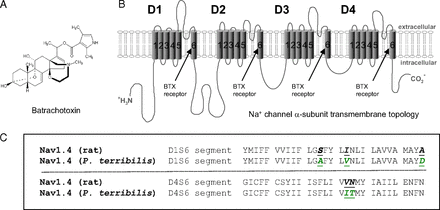黄金箭毒蛙为什么不会被自己毒死
来源:PNAS
作者:Sho-Ya Wang等
时间:2017-09-14


世界上毒性最强的动物很难量化,但世界上最致命的动物之一,毫无疑问是原产于哥伦比亚的黄金箭毒蛙。但它到底是怎么避开自身毒性的?
它们看起来很可爱,但在它们皮肤腺体的下面,却储存着蟾毒素这种生物碱毒。平均而言,这种毒在剂量足够的情况下能杀死十位人类。如果这种毒素进入了你的血液,那么你可能会在十分钟内死亡。
人们已知能够抵抗它的只有一种蛇,并且人们并未找到解毒剂。
这种毒蛙并不能自己制造毒物。当人们在远离黄金箭毒蛙的生活环境中饲养它们时,它们完全无害。因此人们提出了一种理论,即同有毒的河豚一样,这种毒蛙的毒素来自它们的饮食。
那么为什么它们没有被自己毒死呢?为了找出原因,来自纽约州立大学的研究人员们利用小白鼠做了实验。
生物碱通过打开神经细胞的钠通道起作用,这样能够永久阻塞神经信号到肌肉的传递,阻碍肌肉放松。人类的心脏很敏感,最终的后果是心脏衰竭。
河豚的毒素同样作用于钠通道,只是机制略有不同。这两种动物身上均出现了一种氨基酸突变,这种突变改变了它们的钠通道,所以它们才对自身毒素免疫。
研究员 Sho-Ya Wang 与 Ging Kuo Wang 留意到了氨基酸对箭毒蛙的保护。
他们利用老鼠肌肉,测试了 P. terribilis 肌肉中的五种自然氨基酸替代品。当这五种氨基酸被箭毒蛙突变体代替后,老鼠的肌肉能够完全抵抗生物碱。
下一步就是逐一测试这些代替品。这其中只有一种对生物碱高度敏感,有抵抗力的代替品名为 N1584T。对于这种突变体而言,氨基酸天门冬酰胺被氨基酸苏氨酸取代。
先前一哈佛团队做的研究认为箭毒蛙对自身毒性的抵抗力有多个来源;但这一新研究认为同河豚一样,箭毒蛙对毒性的抵抗力来自单个基因突变。
当然,这并不意味着我们能够解毒剂。我们现在仍然不知道河豚的解毒剂。该研究的目的只在于找到让这种濒危动物对自身毒素免疫的突变而已。
该研究总结道:“我们的研究表明 P. terribilis 肌肉钠通道对生物碱毒性的抵抗,主要源自等量 rNav1.4- N1584T 突变。相反的突变是否保留部分抗生物碱特性,仍有待进一步研究。”
该研究已被发表在《美国科学院院报》上。(来源:生物360)
Single rat muscle Na+ channel mutation confers batrachotoxin autoresistance found in poison-dart frog Phyllobates terribilis
Abstract Poison-dart Phyllobates terribilis frogs sequester lethal amounts of steroidal alkaloid batrachotoxin (BTX) in their skin as a defense mechanism against predators. BTX targets voltage-gated Na+ channels and enables them to open persistently. How BTX autoresistance arises in such frogs remains a mystery. The BTX receptor has been delineated along the Na+ channel inner cavity, which is formed jointly by four S6 transmembrane segments from domains D1 to D4. Within the P. terribilis muscle Na+ channel, five amino acid (AA) substitutions have been identified at D1/S6 and D4/S6. We therefore investigated the role of these naturally occurring substitutions in BTX autoresistance by introducing them into rat Nav1.4 muscle Na+ channel, both individually and in combination. Our results showed that combination mutants containing an N1584T substitution all conferred a complete BTX-resistant phenotype when expressed in mammalian HEK293t cells. The single N1584T mutant also retained its functional integrity and became exceptionally resistant to 5 µM BTX, aside from a small residual BTX effect. Single and combination mutants with the other four S6 residues (S429A, I433V, A445D, and V1583I) all remained highly BTX sensitive. These findings, along with diverse BTX phenotypes of N1584K/A/D/T mutant channels, led us to conclude that the conserved N1584 residue is indispensable for BTX actions, probably functioning as an integral part of the BTX receptor. Thus, complete BTX autoresistance found in P. terribilis muscle Na+ channels could emerge primarily from a single AA substitution (asparagine→threonine) via a single nucleotide mutation (AAC→ACC).
原文链接:http://www.pnas.org/content/early/2017/08/29/1707873114.full.pdf




